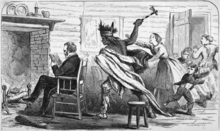Cayuse War
Over the next few years, the Provisional Government of Oregon and later the United States Army battled the Native Americans east of the Cascades.
In addition to evangelizing, the missionaries established schools and grist mills and introduced crop irrigation.
Returning the following year, he joined approximately a thousand settlers traveling to Oregon Country.
The Cayuse suspected that Marcus Whitman—a practicing physician and religious leader, hence a shaman—was responsible for the deaths of their families, causing the disaster to make way for new immigrants.
The Provisional Legislature of Oregon and Governor George Abernethy called for "immediate and prompt action," and authorized the raising of companies of volunteers to go to war, if necessary, against the Cayuse Tribe.
A fifty-person unit of volunteers was raised immediately and dispatched to The Dalles under the command of Henry A. G.
[5] The group was to protect the Wascopam Mission at The Dalles and prevent any hostile forces from reaching the Willamette Valley.
[3] In addition, the governor appointed a peace commission, consisting of Joel Palmer, Lee, and Robert Newell.
[3] In January 1848, a force of over 500 militiamen led by Colonel Cornelius Gilliam (who did not approve of the peace commission) marched against the Cayuse and other native inhabitants of central Oregon.
After reaching the mission, Colonel Gilliam set out to return to The Dalles with a small force to supply that settlement, before continuing to Oregon City to report to the governor.
Many Cayuse resisted, but they were unable to put up an effective opposition to the firepower of their opponents and were driven into hiding in the Blue Mountains.
[6] In 1850, the tribe handed over five members (Tilaukaikt, Tomahas, Klokamas, Isaiachalkis, and Kimasumpkin) to be tried for the murder of the Whitmans.
I was riding on horse back; a white woman came running from the house, she held out her hands and told me not to kill her.
At the war’s end, the crushing debt was unsurprisingly handled with little diplomacy and organization, but was eventually reimbursed through a series of negotiations.
The United States government had tried to pursue a policy of treaty-making with many tribes of the Pacific Northwest; but not after seeking revenge for the Whitman massacre.

